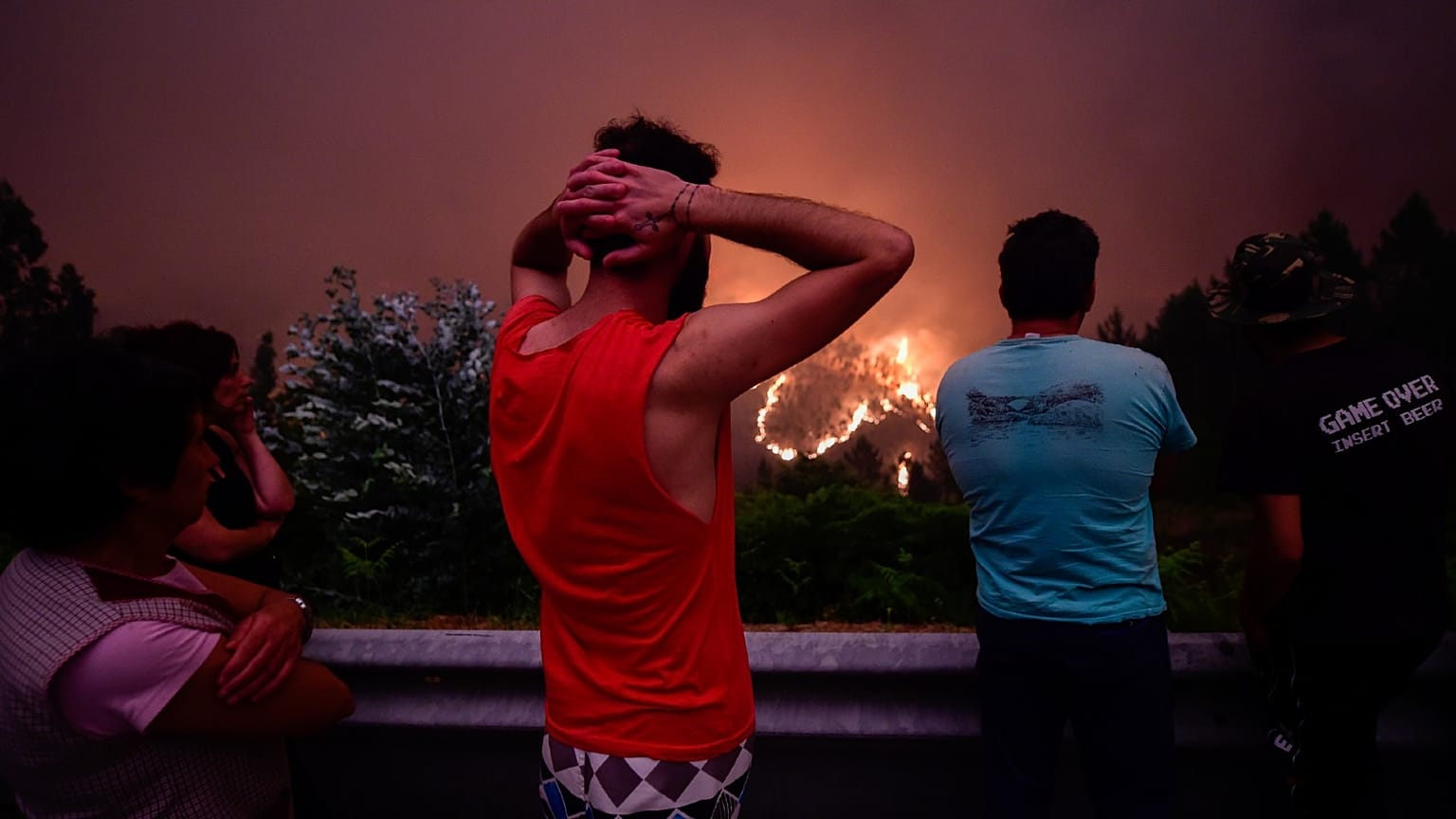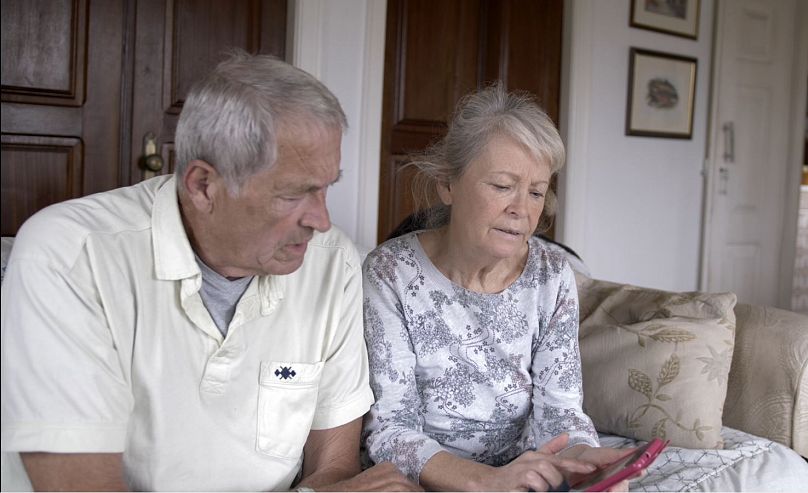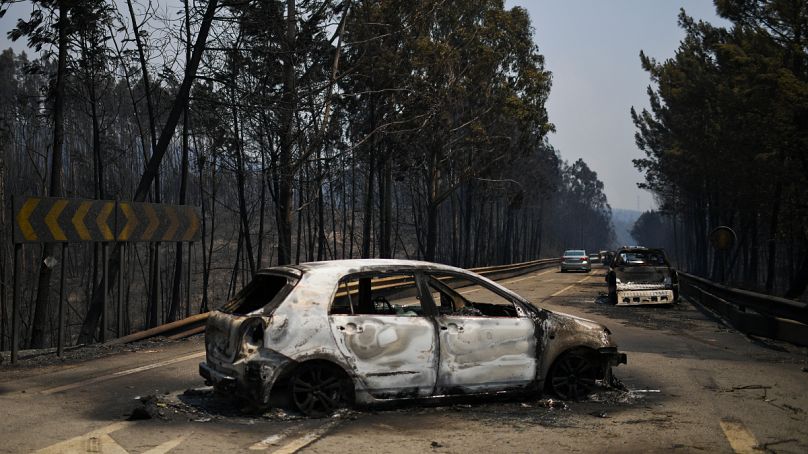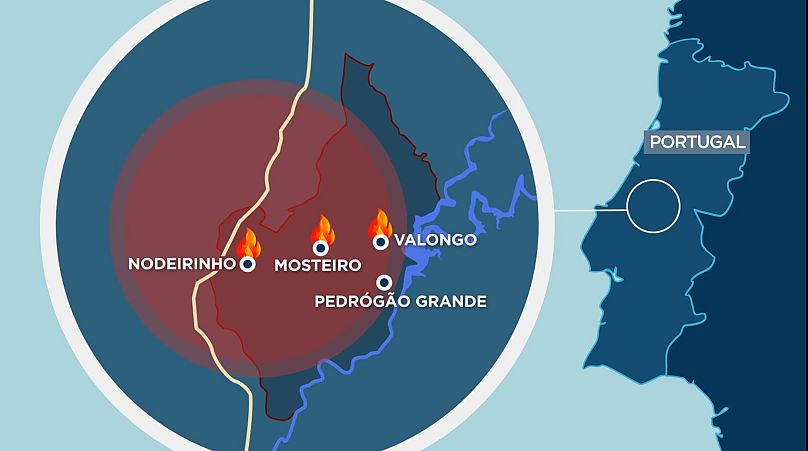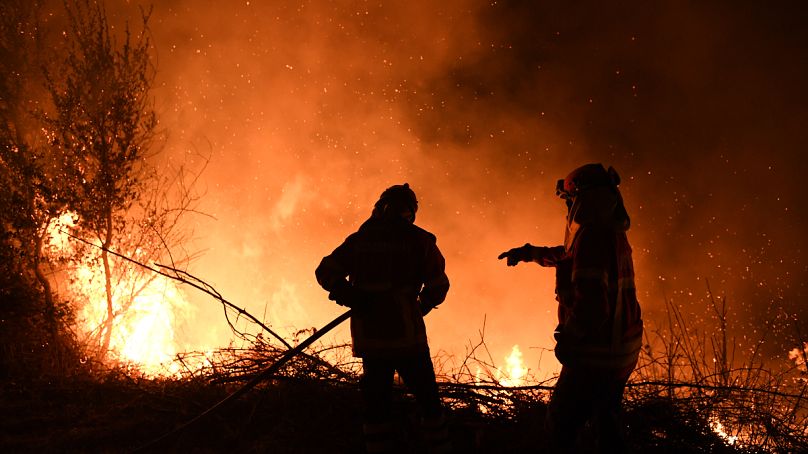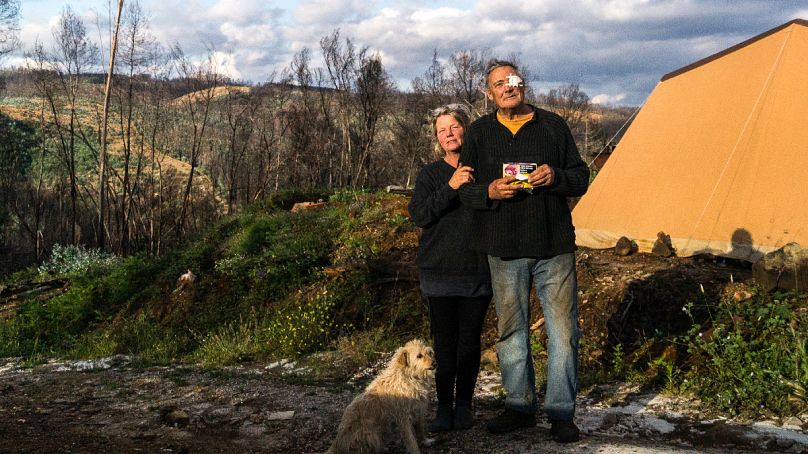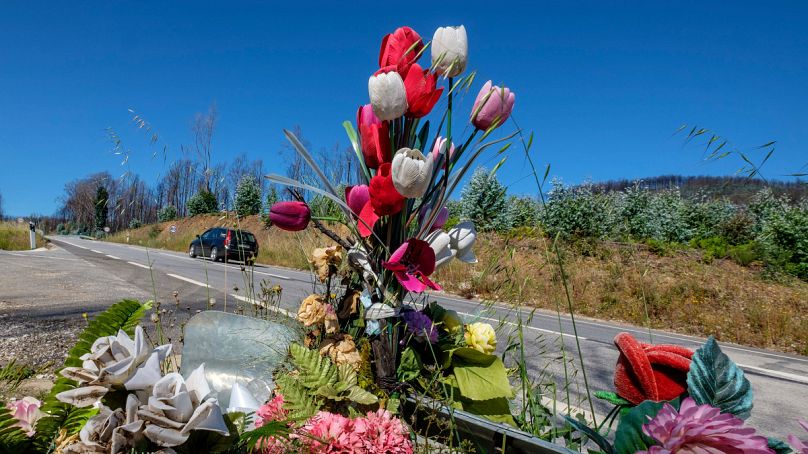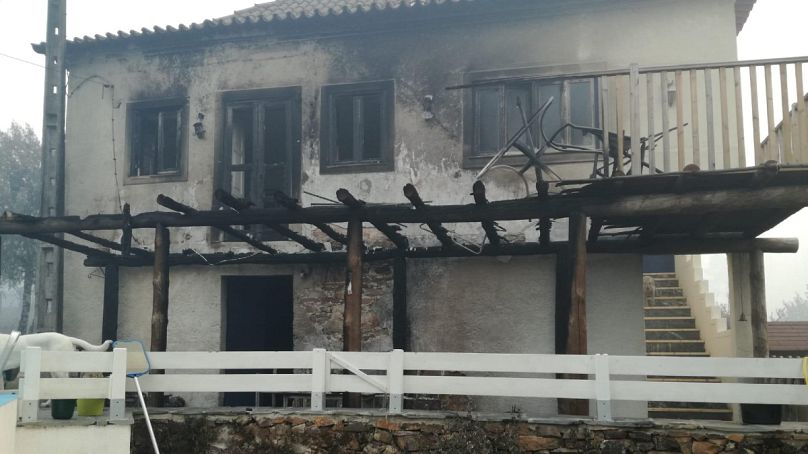Six years ago, a new kind of fire hit Portugal. It killed 66 people. For those lucky enough to survive, the experience still haunts them.
_This article is part of a series originally published in 2020.
All statements date back to the end of 2019.
_
"A huge fireball came flying down the hill onto the house,” said British expat Julie Jennings, recalling the horror of a wildfire turning their Portuguese village into an inferno. “It was terrible, I'll never forget that sound."
The 62-year-old grabbed her donkey and fled. Her partner Chris Nilton followed closely behind with their two dogs, abandoning their dream home in Mosteiro, Pedrógão Grande, which had only been finished 18 months earlier.
“I had about 19 olive trees in the front garden and they were all alight like Roman candles bursting 20 foot in the air,” recalled Chris, 72.
“All the embers were hitting me and the dog. I was only in shorts, bare chest and flip flops. I could feel all these sticking bits of burning wood hitting on me.”
Losing each other within seconds in the thick smoke and howling winds, Chris made for a river, tapping out fires on his head and that of his dog as he went.
“I jumped into the river, went underneath because my head was on fire,” said Chris “I was there probably five minutes and I thought I [have] got to get back up to the hill to the house and see where the hell she is.”
Chris and Julie survived the fires in Pedrógão Grande on 17 June 2017. Haunted by the experience, they have migrated to cooler climes on Portugal’s coast.
The blazes that day killed 66 people, 30 of them in their cars as they were fleeing on the national road 236-1. Another 17 died nearby trying to escape from the cars on foot.
"We have friends in Nodeirinho, we know that a lot of people were killed there,” said Julie. “And our neighbour, Carlos' wife lost her sister, her niece and her great-niece and nephew-in-law who tried to get away from the fire in a car and they all perished.”
A new kind of 'mega-fire'
Portugal is a country used to forest fires.
But the one that hit Pedrógão Grande six years ago was the first of its kind in Europe, according to the World Wide Fund for Nature (WWF) in Spain.
“In June 2017, for the first time in our latitudes, Portugal suffered a new type of fire, unknown to this date by the scientific community: a sixth-generation mega-fire clearly linked to global change,” WWF Spain wrote in a report.
“Extreme, uncontrollable and lethal. A type of fire that was repeated again that same year in Portugal and Spain, and a year later in Greece.
“Climate change is accelerating and intensifying the occurrence of large fires at a quicker step than originally expected: we have moved from not having this type of fires to having the three largest fires in Europe in merely two years, and in the same region.”
Portugal’s typical wildfire season traditionally runs from June to September.
But in 2017, high temperatures throughout the year and low rainfall in the previous spring and winter meant there were around 2,500 fires recorded in April and 3,000 in October, an indicator of how climate change is extending the fire period.
By June a heatwave and a dried-out forest helped the fire create its own micro-climate. Strong and unpredictable winds fanned the flames.
Julie said they had been advised to spray the roof and vegetation around the property’s perimeter with water, normally an effective strategy at stopping the fire’s spread.
But this blaze was different.
“Nothing could have stopped that,” she told Euronews. “It was in the village and from here to Nodeirinho (5km to the west) in probably seven or eight minutes. That's how fast and hot it was travelling.
"It was terrifying and I'll never forget the noise. For me, the noise was the worst thing closely followed by the heat.”
By 9pm, a couple of hours after Chris and Julie had fled their home, the fire hit its peak, moving at 5.3 km/h.
“That made it a completely uncontrolled fire, almost impossible to control at times, becoming a catastrophe and not just a big wildfire as we were used to,” said Rui Barreira, a forest, food and wildlife technician at Portugal Nature Association (ANP).
“These fires were characterised by the high speed of propagation. This can only be related to climate change.”
It took a week to put the fires out. By then they had burned through almost 500 square kilometres of land - an area roughly the size of Andorra.
Then, four months later, in October, tragedy struck again.
A late, out-of-season heatwave intensified the drought and combined with winds from Hurricane Ophelia. It saw another "mega-fire" hit central Portugal, this time about 50 kilometres north of Pedrógão Grande. It killed 51 people.
While 2017 was exceptional, Portugal has been the Mediterranean country hardest hit by forest fires over the last three decades, according to WWF.
“Portugal is one of the countries most affected by climate change,” said EU chief Ursula von der Leyen in December 2019. “Loss of coasts, hurricanes, floods and horrible forest fires have already taken a very high toll.”
‘We are moving because of climate change’
Despite the fire ruining their dream home, Chris and Julie had initially decided to stay in the region.
But constant anxiety and fears of another fire changed their minds.
“When I light a fire I smell the smoke and it brings it all back to me,” said Chris.
“It’s something you never forget, the smell of smoke terrifies us,” added Julie. “We decided to move out to central Portugal near the coast where the temperature will be lower and more consistent. We are moving because of climate change.”
Chris and Julie are not alone. Barreira said in the aftermath of the fires, former residents of the area - many of them younger and living in the cities - came back to Pedrógão Grande to take their parents away, saying the region was no longer safe.
But it’s difficult to get a firm idea on how many left permanently as a result of the fires three years ago, at the time of writing.
Dina Duarte, president of the Pedrógão Grande’s Victims Association (AVIPG), estimates it’s no more than a few dozen, mainly foreigners.
Some have decided to stay. Dutch couple Peter and Marion de Ruite, who live in Salaborda Velha two kilometres away from Mosteiro, had their three-bedroom house destroyed in the fire. They spent a year living in a caravan next to the burned-out shell of their former home.
“The tragedy is more about the people that died than a house destroyed,” said Peter, who arrived in Portugal 15 years ago.
The heat and the dryness of the last few years had pushed the couple to consider moving but they decided to stay.
“If I leave, I leave this region behind which could be very beautiful if we work on it together,” Peter told Euronews. “I shouldn’t just abandon it. I think we should try to make this a better place.”
Nevertheless, people have been leaving the region and well before 2017. Young people especially have departed in search of work in Portugal’s cities. In Pedrógão Grande the population reduced by 20 per cent between 2001 and 2016 and for every 100 young people there are 284 elderly.
“The strong depopulation and ageing of the population, especially of the rural areas in the interior and mountains, have forced the abandonment of all traditional agricultural activities,” said WWF.
“Thus natural vegetation, shrubland, young pioneer forest stand but also monocultural plantation (eucalyptus and pine species) colonised the landscape. They are increasing landscape combustibility and flammability.”
What else caused Portugal's deadly fires?
One of the key problems for many in Portugal is the lack of forest management, which has allowed the propagation of flammable species like pine and eucalyptus.
In 2009, two researchers, Mark Beighley and Albert C. Hyde, raised the issue in a report on Portugal’s forest fire defence strategy.
They predicted that within the next decade that wildfires would burn an area of 500,000 hectares. It happened in 2017.
Writing again in 2018, Beighley and Hyde said the problems they identified 10 years before were still a problem: the high percentage of unmanaged forest lands; the increase in flammable material; the high number of unwanted fire ignitions; and climate change.
“What remains to be seen following Portugal’s catastrophic 2017 fire year is whether there is now consensus on seeing the fire problem as a real national priority,” their report reads.
Julie, for one, has her doubts and thinks the government hasn’t done enough to tackle some of the problems.
“I do know that since the fires people have sold sways of land that have now been planted with eucalyptus again.
“And although I realise that this is a cash crop for people and they need to make a living it needs to be managed properly.
“If it isn't this will continue to happen. To reforest here with more eucalyptus? I don't understand.”
Back in Mosteiro, Chris and Julie reflect on the reality that they are victims of global warming: they have become climate migrants.
“We chose this place because it reminded us of the Lake District: it was green and there were trees and shade. It was just beautiful. But look at it now... it's desolate and we are moving because of climate change. Because that is what is causing the fires to be as they are.
“For Portugal, the eucalyptus can reach so far down that's why the water table is going down. And last summer with record temperatures our little river dried up. That tells you a lot I think about climate change. And it's sad. It makes me very sad.”















